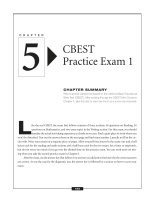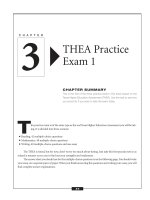Mathematics exam 1 ppt
Bạn đang xem bản rút gọn của tài liệu. Xem và tải ngay bản đầy đủ của tài liệu tại đây (157.93 KB, 6 trang )
Types of Measurements
The types of measurements used most frequently in the
United States are listed below:
Units of Length
12 inches (in.) = 1 foot (ft.)
3 feet = 36 inches = 1 yard (yd.)
5,280 feet = 1,760 yards = 1 mile (mi.)
Units of Volume
8 ounces* (oz.) = 1 cup (c.)
2 cups = 16 ounces = 1 pint (pt.)
2 pints = 4 cups = 32 ounces = 1 quart (qt.)
4 quarts = 8 pints = 16 cups = 128 ounces = 1 gallon
(gal.)
Units of Weight
16 ounces* (oz.) = 1 pound (lb.)
2,000 pounds = 1 ton (T.)
Units of Time
60 seconds (sec.) = 1 minute (min.)
60 minutes = 1 hour (hr.)
24 hours = 1 day
7 days = 1 week
52 weeks = 1 year (yr.)
12 months = 1 year
365 days = 1 year
*Notice that ounces are used to measure both the volume and
weight.
Converting Units
When performing mathematical operations, it is neces-
sary to convert units of measure to simplify a problem.
Units of measure are converted by using either multipli-
cation or division:
■
To change a larger unit to a smaller unit, simply
multiply the specific number of larger units by
the number of smaller units that makes up one of
the larger units.
For example, to find the number of inches in 5
feet, simply multiply 5, the number of larger units,
by 12, the number of inches in one foot:
5 feet = how many inches?
5 feet × 12 inches (the number of inches in a single
foot) = 60 inches
Therefore, there are 60 inches in 5 feet.
Try another:
Change 3.5 tons to pounds.
3.5 tons = how many pounds?
3.5 tons × 2,000 pounds (the number of pounds in
a single ton) = 6,500 pounds
Therefore, there are 6,500 pounds in 3.5 tons.
■
To change a smaller unit to a larger unit, simply
divide the specific number of smaller units by the
number of smaller units in only one of the larger
units.
For example, to find the number of pints in 64
ounces, simply divide 64, the smaller unit, by 16,
the number of ounces in one pint.
= 4 pints
Therefore, 64 ounces are equal to four pints.
Here is one more:
Change 24 ounces to pounds.
= 2 pounds
Therefore, 32 ounces are equal to two pounds.
Basic Operations with
Measurement
It will be necessary for you to review how to add, sub-
tract, multiply, and divide with measurement. The
mathematical rules needed for each of these operations
with measurement follow.
Addition with Measurements
To add measurements, follow these two steps:
1. Add like units.
2. Simplify the answer.
32 ounces
ᎏᎏ
16 ounces
64 ounces
ᎏᎏ
16 ounces
specific number of the smaller unit
ᎏᎏᎏᎏᎏ
the number of smaller units in one larger unit
– MEASUREMENT AND GEOMETRY–
390
Example: Add 4 pounds 5 ounces to 20 ounces.
4 lb. 5 oz. Be sure to add ounces to ounces.
+
20 oz.
4 lb. 25 oz. Because 25 ounces is more than 16
ounces (1 pound), simplify by
dividing by 16. Then add the 1
pound to the 4 pounds.
4 lb. + 25 oz.
1 lb.
4 lb. + 16ͤ25
ෆ
−16
9 oz.
4 pounds 25 ounces =
4 pounds + 1 pound 9 ounces =
5 pounds 9 ounces
Subtraction with Measurements
1. Subtract like units.
2. Regroup units when necessary.
3. Write the answer in simplest form.
For example, to subtract 6 pounds 2 ounces
from 9 pounds 10 ounces,
9 lb. 10 oz. Subtract ounces from ounces.
−
6 lb. 2 oz. Then, subtract pounds from pounds.
3 lb. 8 oz.
Sometimes, it is necessary to regroup units when
subtracting.
Example: Subtract 3 yards 2 feet from 5 yards 1
foot.
5
4
yd. 1
4
ft.
− 3 yd. 2 ft.
1 yd. 2 ft.
From 5 yards, regroup 1 yard to 3 feet. Add 3
feet to 1 foot. Then subtract feet from feet and
yards from yards.
Multiplication with Measurements
1. Multiply like units.
2. Simplify the answer.
Example: Multiply 5 feet 7 inches by 3.
5 ft. 7 in. Multiply 7 inches by 3, then multiply 5
× 3 feet by 3. Keep the units separate.
15 ft. 21 in. Since 12 inches = 1 foot, simplify 21
inches.
15 ft. 21 in. = 15 ft. + 1 ft. + 9 inches =
16 feet 9 inches
Example: Multiply 9 feet by 4 yards.
First, change yards to feet by multiplying the
number of feet in a yard (3) by the number of
yards in this problem (4).
3 feet in a yard × 4 yards = 12 feet
Then, multiply 9 feet by 12 feet =
108 square feet.
(Note: feet × feet = square feet)
Division with Measurements
1. Divide into the larger units first.
2. Convert the remainder to the smaller unit.
3. Add the converted remainder to the existing
smaller unit if any.
4. Then, divide into smaller units.
5. Write the answer in simplest form.
Example:
Divide 5 quarts 4 ounces by 4.
1 qt. R1 First, divide 5 ounces
1. 4ͤ5
ෆ
ෆ
by 4, for a result of 1
−4 quart and a reminder
1 of one.
2. R1 = 32 oz. Convert the remainder
to the smaller unit
(ounces).
3. 32 oz. + 4 oz. = 36 oz. Add the converted
remainder to the
existing smaller unit.
4. 9 oz. Now divide the smaller
4ͤ36
ෆ
units by 4.
5. 1 qt. 9 oz.
– MEASUREMENT AND GEOMETRY–
391
Metric Measurements
The metric system is an international system of meas-
urement also called the decimal system. Converting units
in the metric system is much easier than converting
units in the English system of measurement. However,
making conversions between the two systems is much
more difficult. Luckily, the GED test will provide you
with the appropriate conversion factor when needed.
The basic units of the metric system are the meter,
gram, and liter. Here is a general idea of how the two sys-
tems compare:
METRIC S
YSTEM ENGLISH SYSTEM
1 meter A meter is a little more than a
yard; it is equal to about 39 inches.
1 gram A gram is a very small unit of
weight; there are about 30 grams
in one ounce.
1 liter A liter is a little more than a quart.
Prefixes are attached to the basic metric units listed
above to indicate the amount of each unit.
For example, the prefix deci means one-tenth (
ᎏ
1
1
0
ᎏ
);
therefore, one decigram is one-tenth of a gram, and one
decimeter is one-tenth of a meter. The following six pre-
fixes can be used with every metric unit:
Kilo Hecto Deka Deci Centi Milli
(k) (h) (dk) (d) (c) (m)
1,000 100 10
ᎏ
1
1
0
ᎏ
ᎏ
1
1
00
ᎏ
ᎏ
1,0
1
00
ᎏ
Examples:
■
1 hectometer = 1 hm = 100 meters
■
1 millimeter = 1 mm =
ᎏ
1,0
1
00
ᎏ
meter =
.001 meter
■
1 dekagram = 1 dkg = 10 grams
■
1 centiliter = 1 cL* =
ᎏ
1
1
00
ᎏ
liter = .01 liter
■
1 kilogram = 1 kg = 1,000 grams
■
1 deciliter = 1 dL* =
ᎏ
1
1
0
ᎏ
liter = .1 liter
*Notice that liter is abbreviated with a capital letter—“L.”
The chart shown here illustrates some common rela-
tionships used in the metric system:
Length Weight Volume
1 km = 1,000 m 1 kg = 1,000 g 1 kL = 1,000 L
1 m = .001 km 1 g = .001 kg 1 L = .001 kL
1 m = 100 cm 1 g = 100 cg 1 L = 100 cL
1 cm = .01 m 1 cg = .01 g 1 cL = .01 L
1 m = 1,000 mm 1 g = 1,000 mg 1 L = 1,000 mL
1mm = .001 m 1 mg = .001 g 1 mL = .001 L
Conversions within the Metric
System
An easy way to do conversions with the metric system is
to move the decimal point to either the right or the left
because the conversion factor is always ten or a power of
ten. As you learned previously, when you change from a
large unit to a smaller unit, you multiply, and when you
change from a small unit to a larger unit, you divide.
Making Easy Conversions within
the Metric System
When you multiply by a power of ten, you move the dec-
imal point to the right. When you divide by a power of
ten, you move the decimal point to the left.
To change from a large unit to a smaller unit, move
the decimal point to the right.
kilo hecto deka UNIT deci centi milli
To change from a small unit to a larger unit, move the
decimal point to the left.
Example:
Change 520 grams to kilograms.
Step 1: Be aware that changing meters to kilome-
ters is going from small units to larger units, and
thus, you will move the decimal point three places
to the left.
Step 2: Beginning at the UNIT (for grams), you
need to move three prefixes to the left.
یی ی
k h dk unit d c m
– MEASUREMENT AND GEOMETRY–
392
Step 3: Move the decimal point from the
end of 520 to the left three places. 520.
Place the decimal point before the 5. .520
Your answer is 520 grams = .520 kilograms.
Example:
You are packing your bicycle for a trip from
New York City to Detroit. The rack on the back
of your bike can hold 20 kilograms. If you
exceed that limit, you must buy stabilizers for
the rack that cost $2.80 each. Each stabilizer can
hold an additional kilogram. If you want to pack
23,000 grams of supplies, how much money will
you have to spend on the stabilizers?
Step 1: First, change 23,000 grams to kilograms.
یی ی
kg hg dkg g dg cg mg
Step 2: Move the decimal point three places to the
left.
23,000 g = 23.000 kg = 23 kg
Step 3: Subtract to find the amount over the limit.
23 kg − 20 kg = 3 kg
Step 4: Because each stabilizer holds one kilogram
and your supplies exceed the weight limit of the
rack by three kilograms, you must purchase three
stabilizers from the bike store.
Step 5: Each stabilizer costs $2.80, so multiply
$2.80 by 3: $2.80 × 3 = $8.40.
Geometry
As previously defined, geometry is the study of shapes
and the relationships among them. Basic concepts in
geometry will be detailed and applied in this section. The
study of geometry always begins with a look at basic
vocabulary and concepts. Therefore, here is a list of def-
initions of important terms:
area—the space inside a two-dimensional figure
bisect—cut in two equal parts
circumference—the distance around a circle
diameter—a line segment that goes directly through
the center of a circle—the longest line you can
draw in a circle
equidistant—exactly in the middle of
hypotenuse—the longest leg of a right triangle,
always opposite the right angle
line—an infinite collection of points in a straight
path
point—a location in space
parallel—lines in the same plane that will never
intersect
perimeter—the distance around a figure
perpendicular—two lines that intersect to form 90-
degree angles
quadrilateral—any four-sided closed figure
radius—a line from the center of a circle to a point
on the circle (half of the diameter)
volume—the space inside a three-dimensional
figure
– MEASUREMENT AND GEOMETRY–
393
Angles
An angle is formed by an endpoint, or vertex, and two
rays.
Naming Angles
There are three ways to name an angle.
1. An angle can be named by the vertex when no
other angles share the same vertex: ∠A.
2. An angle can be represented by a number written
across from the vertex: ∠1.
3. When more than one angle has the same vertex,
three letters are used, with the vertex always
being the middle letter: –1 can be written as
∠BAD or as ∠DAB; –2 can be written as ∠DAC
or as ∠CAD.
Classifying Angles
Angles can be classified into the following categories:
acute, right, obtuse, and straight.
■
An acute angle is an angle that measures less than
90 degrees.
■
A right angle is an angle that measures exactly 90
degrees. A right angle is represented by a square
at the vertex.
■
An obtuse angle is an angle that measures more
than 90 degrees, but less than 180 degrees.
■
A straight angle is an angle that measures 180
degrees. Thus, its sides form a straight line.
Straight Angle
180°
Obtuse Angle
Right
Angle
A
cute
Angle
1
2
A
C
D
B
Endpoint (or Vertex)
ray
ray
– MEASUREMENT AND GEOMETRY–
394
COMPLEMENTARY
ANGLES
Two angles are complementary if the sum of their meas-
ures is equal to 90 degrees.
SUPPLEMENTARY ANGLES
Two angles are supplementary if the sum of their meas-
ures is equal to 180 degrees.
ADJACENT ANGLES
Adjacent angles have the same vertex, share a side, and do
not overlap.
The sum of the measures of all adjacent angles around
the same vertex is equal to 360 degrees.
Angles of Intersecting Lines
When two lines intersect, two sets of nonadjacent angles
called vertical angles are formed. Vertical angles have
equal measures and are supplementary to adjacent
angles.
■
m∠1 = m∠3 and m∠2 = m∠4
■
m∠1 + m∠2 = 180 and m∠2 + m∠3 = 180
■
m∠3 + m∠4 = 180 and m∠1 + m∠4 = 180
Bisecting Angles and Line
Segments
Both angles and lines are said to be bisected when
divided into two parts with equal measures.
Example
Line segment AB is bisected at point C.
According to the figure, ∠A is bisected by ray AC.
35°
35°
1
2
3
4
1
2
3
4
∠1 + ∠2 + ∠3 + ∠4 = 360°
1
2
∠
1 and ∠2 are adjacent.
Adjacent
Angles
1
2
∠1 + ∠2 = 180°
Supplementary
Angles
1
2
∠1 + ∠2 = 90°
Complementar
y
Angles
– MEASUREMENT AND GEOMETRY–
395









